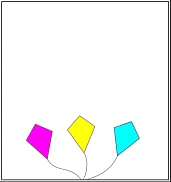|
The
brain is able to fill in (reconstruct)
gaps of detail missing in an image. It is
also capable of creating successive images,
a curious effect discovered by a French
chemist, Michael-Eugene Chevreul circa
1840, when he also discovered the phenomenon
he called " simultaneous
" or " reciprocal
contrast
", based on the principle of complementary
colours. Click on the primary coloured
kites. Look at the Magenta,
cyan,
and yellow
kites for 30 seconds, then look up at the
white space above, and you will notice an
almost fluorescent appearance of an after
image of the kites in their complementary
colours; green,
blue,
and red. |

Primary Kites |